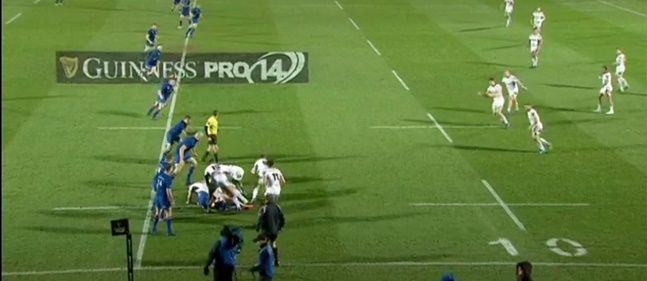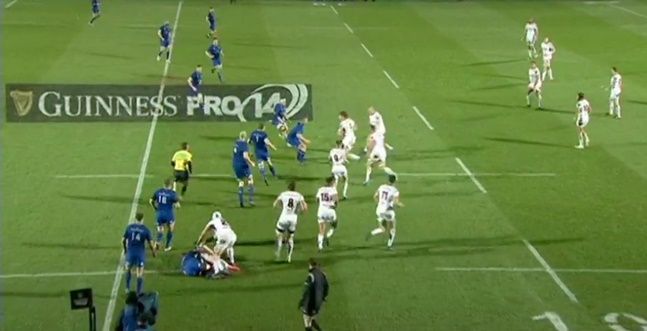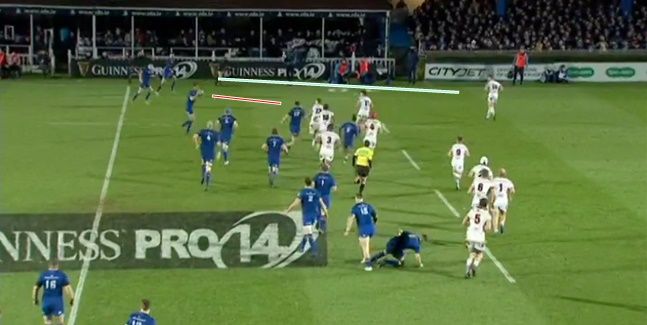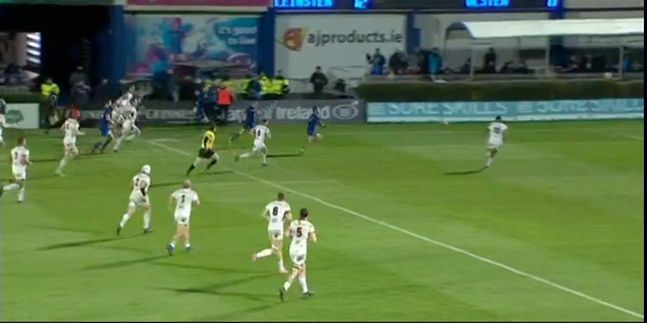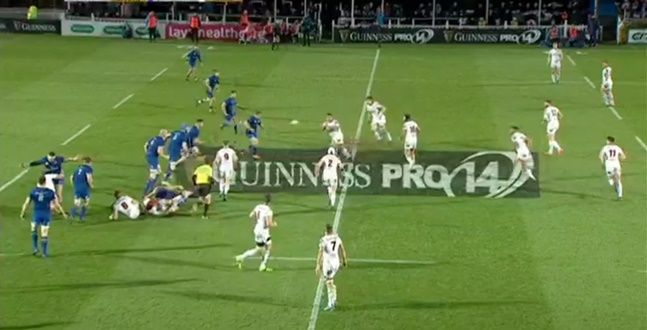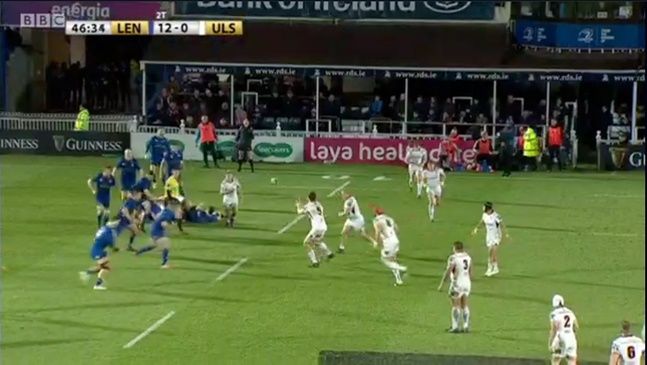What can statistics tell you about a game?
Match statistics can tell you that Leinster made more metres than Ulster in their 38-7 win at the RDS on Saturday.
Statistics can tell you that the hosts made nearly twice as many tackles. That they had more territory but less possession. But statistics can explain only so much.
Statistics will tell you that Jordan Larmour made three linebreaks and beat four defenders. That he scored two tries and assisted another.
But statistics can’t quantify his lethal left foot step. They can’t tell you about Iain Henderson’s last ditch tackle or Jamison Gibson-Park’s overeagerness in retrieving kicks, and they can’t really account for factors like linespeed and aggression in the tackle.
Statistics may show that Leinster picked up 560 metres on the ground compared to Ulster’s 428 metres, but realistically, Ulster were continually stifled in the carry, and when they couldn’t find their way over the gainline, they turned the ball over and were punished for their ineffectiveness.
Part of this can be attributed to a weak Ulster pack, who have been heavily criticised for their many shortcomings this season, but with that said, Leinster were brilliant at getting off the line and driving a rudderless Ulster side further and further back behind the gainline.
Their opening two tries came through the brilliance of Larmour, the first, a strong support line to Fergus McFadden, the second, a delayed pass to Barry Daly after Darren Cave froze when trying to deal with Larmour’s quick feet.
But his third score, a disallowed try that was brought back after Gibson-Park was ruled to be ahead of the kicker, came as a direct result from Leinster’s linespeed and their ability to transition from defence to attack.
In the picture above there is a small gap between Jordi Murphy and Jack McGrath as the Leinster captain realigns.
When Ulster scrum-half Johnny Stewart fires the ball to Henderson, McGrath has squared his shoulders and creates a one-on-one opportunity to tackle his Ireland teammate.
The Ireland prop takes Henderson in a routine tackle around the waist bringing him down behind the gainline.
Leinster reload defensively and when the ball is passed to flanker Matthew Rea on the next phase, there are four blue shirts with their eyes fixated on the ball carrier.
Rea coincidentally drops the pass, and Jack Conan dives on the loose ball, with Jordi Murphy then stepping in as a temporary scrum-half.
The Leinster flanker then fires the ball to Scott Fardy who shifts it one pass wide to Robbie Henshaw, who then passes to Sexton with a three-on-three opportunity against a desparately staggered Ulster defensive line.
Sexton draws Cave in by holding his line and shifting the ball to Larmour, who takes advantage of the space between Jacob Stockdale and Andrew Trimble with a perfectly weighted grubber kick in behind the defence.
A few seconds later and Larmour is crossing for what appeared to be his second try of the game.
Gibson-Park is ahead of the kicker, but Larmour shows great pace to link up with the scrum-half who takes the cover defender Charles Piutau to the corner before popping a beautiful inside ball to Larmour who crosses the line untouched. The try is disallowed, but a couple of minutes later a similar situation arises.
Scrum-half Johnny Stewart delivers the ball from a ruck in the Leinster half to Rodney Ah You who stands in front of fly-half Christian Leali’ifano (circled in yellow).
Sean Cronin comes hard out of the line, potentially recognising the three-on-three opportunity (or four-on-three if Charles Piutau loops around white #1 Sutart McCloskey) on the outside should Stewart pass the ball to Leali’ifano instead.
Stewart goes short to Ah You, who you can see Cronin is right on top of, before he receives the ball.
Ah You takes the pass and the tackle not too much further from where he receives the ball.
Ulster wrap around on the next play and makes some nice metres through Jacob Stockdale before Leinster realign and jam in hard on Iain Henderson on the next play.
Once again, Cronin leads the line alongside Andrew Porter and both players put pressure on Henderson before he can receive the ball.
The tackle is made, and without breaking it down phase by phase, Leinster stuff Ulster on the next two plays, first, through Garry Ringrose who makes a textbook tackle on Darren Cave, and then through Robbie Henshaw who makes a similar takcle on Stuart McCloskey a phase later.
Leinster get off their line on consecutive plays and Leali’ifano has consequently been forced to avoid his foward runners on back-to-back phases.
https://www.youtube.com/watch?v=eAeqnyHI7wU&feature=youtu.be
Ringrose and Henshaw make great tackles, after good reads, and Ulster have lost around 15 metres on two plays. Backpeddaling at a rate of knots, Leali’ifano drops into the pocket and clears the ball to Gibson-Park who passes it to… yes… Jordan Larmour.
The 20-year-old chips the ball over the Ulster defence and retrieves his kick with a bit of luck. Jack McGrath takes the next carry forward and Leinster are in a great attacking position in the Ulster half.
As seen above, one phase later and Fergus McFadden has crossed for his first score of the game after a great switch from Sean Cronin and some very average defence from Jacob Stockdale.
Similarly, on McFadden’s second score a few minutes later, Leinster absorb phase after phase before Henshaw strips Cave of the ball before Leinster recycle.
McGrath passes to Murphy who shifts it wide to Porter who does the rest from there with a fantastic run before finding Gibson-Park with a questionable pass. Taking the ball at full pace, the New Zealander then sends McFadden racing towards the try-line with the final pass.
There’s an argument for a forward pass from Porter, and there’s another example of a weak attempt from Stockdale, as well as another shocker from Cave with ball in hand, but Leinster showed once again that they can strike very quickly off the counter-attack.
Throughout the second-half, Leinster dominated the Ulster pack with their linespeed and ultimately forced 17 turnovers.
Even on the last play of the game where Johnny Sexton cruises to the line untouched, susbtitute prop Ed Byrne makes the hit on Ah You, forces the ball loose, and Leinster are off to the races through Murphy, Noel Reid and Max Deegan, who holds off the challenge of Rob Herring before setting Sexton free with the final offload after a super ball from Reid with the penultimate pass.
Jordan Larmour’s performance is the big takeaway from a game that was realistically over as a contest not too long after the 15 minute mark, but Leinster forged their win on the back off their linespeed, their accuracy in the tackle, and their ability to punish the opposition within a few phases of turning the ball over.
Glasgow take note.

